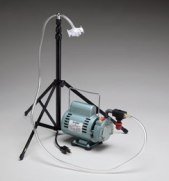Find a Mold Specialist Now
Click or Call, Toll-Free 24/7
Mold Count
Does Your Home Have Toxic Mold?
If you’re suffering symptoms of exposure to mold, you may want to know the mold count in your home. The higher the mold spore count, the more severe symptoms you can expect to experience. While there are many, many types of mold found throughout the United States, the Asthma and Allergy Foundation of America reports that only a few dozen types, including Aspergillus, Penicillium, Cladosporium, Epicoccum and Fusarium cause allergic reactions in some people. For those that suffer allergies to mold, though, a high mold count causes many miserable symptoms.
Symptoms of exposure to a high mold spore count include things like coughing; sneezing; runny nose or stuffy nose; itchy, irritated nose and throat; itchy, watery eyes; dark colored circles under the eyes and even asthma attacks or upper respiratory infections, in severe cases. Symptoms typically resemble symptoms of hay fever. However, symptoms may include a skin rash, dizziness, short term memory problems, depression and fatigue.
While anyone can be bothered by mold spores in the air, some people are more susceptible to problems from mold than others. The very young and the very old are more likely to be bothered by mold, as are those that have pre-existing respiratory problems or problems with the immune system like HIV or AIDS.
Getting a Mold Spore Count
If you suspect a mold problem in your home or have symptoms of exposure to mold, we recommend that you have a professional come in and test your home for mold. If you prefer, you can purchase a test kit to use yourself at home, but a professionally-administered test will be more accurate.
Do-it-yourself mold tests generally work by exposing a dish of an oily solution to the air or exposing a rod covered with a greasy solution to the air for a while. The solution collects mold spores from the air. The spores then grow in visible colonies and different types of mold will be different colors and shapes. Professionals, on the other hand, typically have a different type of test, which is more accurate. It’s a machine that sucks in air.
If you purchase a test kit to do a test yourself, it will come with an instruction sheet explaining how to read the results of your test, but a professional will be trained to read and interpret the results and will also know what results are normal in your area of the country. What’s normal does vary widely from geographical location to location.
What the Mold Count Means
The mold count tells you how many mold spores are in the air in an area. You can compare it to whatever’s normal for an area, if you know, or compare results from day to day. However, it’s important to note what kind of mold you’re dealing with. Sometimes people just give the mold spore count as a number, but without knowing which type of mold it is, that number is fairly meaningless. Some molds can cause symptoms in just small concentrations, while others are fairly benign except in very large amounts.
What Type of Mold It Is
When you get a mold spore count, you want to know what type of mold it is. Different types of mold cause different symptoms, and you might be allergic to some types but not others. Also, different types need different conditions to grow and thrive. Mold usually grows most rapidly in very wet weather but the amount of moisture available may affect the type of mold that grows. This is yet another reason to have a professional mold tester give you a mold count; he or she should be knowledgeable about different types of molds.
What to Expect from a Professional Mold Tester
- Expect a professional with extensive education and experience related to his field. Many professional mold testers are engineers.
- Expect a professional to inspect your entire home for mold. He will likely locate mold in areas where you have not yet noticed it.
- Expect a written mold removal protocol complete with safety precautions.
- Expect to receive information about the severity of your mold problem and the specific health risks you face from exposure.
- Expect a professional to visit your home and test for mold again after the mold removal has been completed to make sure the job was done thoroughly.
For a list of professional mold testers in your area, just follow this link.
Return From Mold Count To Our Main Toxic Mold Test Page
Black Mold Health Symptoms Home Page





